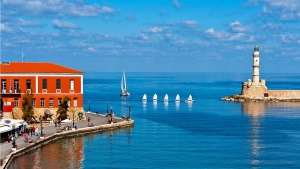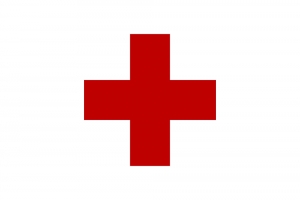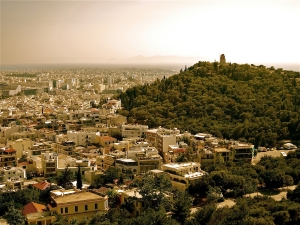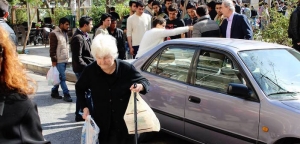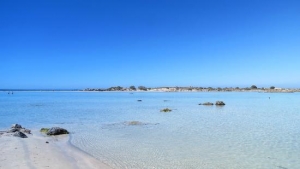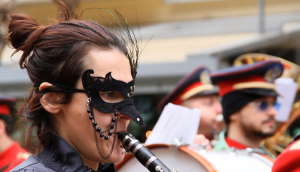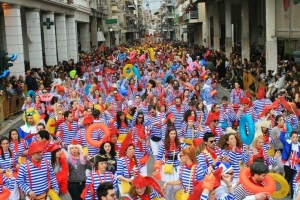ABOUT US
XpatAthens
Wednesday, 09 March 2016 11:32
8 Greek Cities Among Europe's 16 Oldest Cities
Europe is rich in geography and history which means that there are so many options for excellent travel experiences on the continent. Considering its small size, fortunately Greece is a country full of incredible places to explore and enjoy.
This article from the Telegraph tells us that 8 Greek cities are among Europe's oldest cities! Pull out your trusty maps (or plan your Google map route) and head to some of the oldest cities in Europe ~ they're right at your doorstep!
Argos, Greece
When did the earliest inhabitants settle? 5,000 BC
Árgos, in the north-eastern Peloponnese, 12km from Nafplio, has been inhabited, at least as a village, for some 7,000 years, and was a significant centre during the Mycenaean period (1600-1100 BC), although became most prominent during the reign of the tyrant king Pheidon, in the 7th century BC. In the Greek myths, the city was named after the son of Zeus and Niobe, and Homer's Iliad describes it as a renowned horse-breeding centre. Hera, the goddess of women and marriage, was particularly revered, and the Argives honoured her with a temple and an annual festival. Mycenaean tombs, the sanctuary of Aphrodite and a theatre with capacity for 20,000 people can be seen today.
Athens, Greece
When did the earliest inhabitants settle? 5,000 BC
The Acropolis has been inhabited since at least 5,000 BC, and Greek legend says that the city of Athens won its name after Athena planted an olive seed in a contest with Poseidon. With the resulting tree seen as more valuable than the water that Poseidon released from a rock with his trident, the goddess of wisdom, war and the crafts was named as the city's patron. The birthplace of democracy, the city has been held in such esteem that invaders have historically conquered the city, but not ransacked it, or enslaved its citizens. The Athenians defeated the Persians at the Battle of Marathon in 490 BC, after which the city entered its golden age, under the rule of Pericles. Socrates, Hippocrates and Sophocles all worked in its bounds, to be followed by Aristotle and Plato. Today, visitors can admire the Acropolis as well as Plaka, the city's oldest residential quarter, and Mt Lycabettus, the highest vantage point and a world away from any financial worries.
Chania, Crete
When did the earliest inhabitants settle? 4,000 BC
Excavations of the ancient city of Kydonia are taking place on Kastelli hill above the harbour at Chania on Crete. The ruins are thought to date from the Minoan period (2,100-1,100BC) and Kydonia probably came into its own around then, but traces of inhabitation at the site date back to the Neolithic period. Homer said that the city was one of the most important of the time, and frescoes, pottery and coins have all been unearthed on the site, which is open to view today. It is thought that the Saracens destroyed Kyronia in around 828, and the Venetians later built on it the settlement that would become modern-day Chania. The city is arguably Crete's most attractive, with its walls, beaches, museums, boats and all important tavernas creating an amiable atmosphere.
Patra, Greece
When did the earliest inhabitants settle? c. 3,500 BC
Excavations show that the area that is now the city of Patra has been inhabited since the Early Helladic period in the middle of the 3rd millennium BC. Like many other cities in Greece, it was later occupied by the Turks, while it was then set on fire by Muslim Albanians in 1779. After an earthquake in the 6th century, a castle was built on the side of Mount Panachaico, and to this day the city is divided into Lower and Upper districts. The modern city, on the coast in western Greece, has around 200,000 inhabitants.
Trikala, Greece
When did the earliest inhabitants settle? 3,000 BC
The ancient city of Trikka, founded around the 3rd millennium BC, lies underneath the modern conurbation, and was named after the nymph Trikke, daughter of Penaeus. The riverside location in central mainland Greece led to prosperity, although it fell to the Achaemenid Persians in 480 BC and later to the Romans. The Asklepieion - a healing temple - is one of the most ancient ruins of its kind, while the 17th century Koursoum Mosque is a more modern attraction.
Thebes, Greece
When did the earliest inhabitants settle? 3,000 BC
Evidence of buildings with rock-cut foundations, drains and mud brick walls shows Thebes has been inhabited for some 5,000 years, although the placement of the modern town on top of the ruins has made piecing together the history of the ancient settlement difficult. Found in central Greece, the city is important in Greek mythology, supposedly as the birthplace of Hercules and the terrorising ground of the Sphinx before her riddle was solved. Today, Thebes is a market city, and although some tourists come to see ruins, other bigger draws nearby such as Athens keep visitor numbers relatively low.
Chalcis (Halkida), Greece
When did the earliest inhabitants settle? At least 1,300 BC
Homer refers to Chalcis in the Iliad, written in about 762 BC, meaning that the city is at least 2,800 years old. Indeed, academic records say that the city was founded before the Trojan War, typically thought to have been between the 12th and 13th centuries BC, by an Ionic colony from Athens. It is the main settlement on the island of Euboea, where it sits on the Europis strait, a channel of water separating the island from mainland Greece. Although it was significant during the Roman era, nothing remains of the old city today, and the town is best known as a holiday resort for Greeks, for its agriculture, and its neighbouring cement factory.
To learn about all 16 European cities, please visit: Telegraph
Published in
Travel Greece
Tagged under
Wednesday, 09 March 2016 11:13
ReGeneration: Halting Greece's Brain Drain
In September 2012 two friends meet up on the rooftop of a building in New York. Panagiotis Madamopoulos-Moraris is in town for business and Nikos Koumettis is an already successful senior executive at The Coca-Cola Company. They are discussing the difficult circumstances in Greece and the high number of Greek scientists looking for work in the US. The two friends decide to do something to stop the brain drain in Greece. This is how ReGeneration was born – an initiative that aims to become the catalyst of internship culture in Greece.
ReGeneration is an initiative of the Global Shapers Athens Hub, a program of the World Economic Forum. As Spiros Milonas, ReGeneration’s project manager, explained, “Our aim is to give high-caliber young graduates with little or no work experience the opportunity to kick-start their career at a company in Greece, and in a job relevant to their studies and in a position that fits their personality.”
Designed by experts in human resources management, the program assists participants in discovering their capabilities and career path by combining academic background and talent through five stages. “This is how companies that participate in the program recruit the best minds and those who will evolve into the ideal business partner,” said Madamopoulos-Moraris, first curator of the Global Shapers Athens Hub.
ReGeneration is funded by The Hellenic Initiative (THI) and The Coca-Cola Company. The program’s success after just two years validates the “experiment,” Michael Printzos, program director at THI, told Kathimerini. He said that during 2014, the program’s first year, some 3,000 applications were received for positions at 21 participating companies, both Greek and multinational. A total of 55 paid internship positions were created and filled thanks to the program, and, at the end of the internship period, 80 percent of the interns renewed their contracts.
To read more, please visit: eKathimerini
Published in
Local News
Tagged under
Tuesday, 08 March 2016 12:20
What's Up Doc ~ Health Services In Athens In English
Navigating the Greek healthcare system can sometimes challenge even the most 'zen' personalities. Finding, booking, communicating with and paying for specialized practitioners does not always happen in one smooth straight line...
In the past few days I've had appointments for a couple 'standard check-ups' - one to check my failing eyesight and the other a visit the dreaded dentist. I asked around for suggestions on 'good' clinics in the city centre, and was pleasantly surprised at the high level of care and service.
The dental office of Dr. Laghios looks more like a private airport lounge than a medical office - gorgeous design, flatscreen TVs, relaxing music and wifi. Equipment as modern as any I've seen before, and great friendly staff. And an Easy location 30m away from the Megaro Mousikis metro stop. They even called me the next day to ask if I was ok after my treatment - that's a first! All my 'boxes' were 'checked'.
The ‘Eye Clinic’ is also just outside the Megaro Mousikis station. This is a larger clinic that has a number of ophthalmologists on staff. Modern spaces, quick checkup, pay by credit card, everything in English – very pleasant.
In my view, an important part of medical treatment is trust - trust in the doctor, trust in the facilities and equipment, trust that you are receiving the best available care. The clinics I visited did just that. Modern facilities, pleasant (and English-speaking) staff, and overall a very 'civilized' experience.
If you’re looking for medical services and you’re not sure where to start, there are a number of websites and apps out there that can help. These sites allow you to quickly search for doctors based on medical specialty, your location and your insurance coverage. You can then read the 'profiles' of the relevant doctors and make an appointment directly through the sites. Simple.
Here are a few of the better-known sites to find an English speaking doctor in Greece:
DoctorAnytime
DOC
Find Your Doctor
With doctors just a click away, maybe now is a great time for a spring check-up?
DoctorAnytime
DOC
Find Your Doctor
With doctors just a click away, maybe now is a great time for a spring check-up?
Until next week,
Jack
Dr. Constantinos Laghios (Dentist)
Papadiamantopoulou 4
+30 210 72 13 598
info@endodontic.org
Eye Clinic
Leof. Vasilissis Sofias 64
+30 210 361 4700
Published in
My Week In Athens
Tagged under
Monday, 07 March 2016 12:54
Free Things To Do In Athens
Athens is a vibrant and multifaceted city with over 3.000 years of history. There are truly many things to do and see, and many things can be experienced on a budget. Some can even be enjoyed for free! Below, TravelPassionate shares some great ideas for discovering Athens for free.
Book A Free Tour With A Local
This Is Athens has a great program where you get in touch with locals, and depending on your needs and interests you can arrange a free tour with them. Whether you are a history buff, a foodie, a shopping enthusiast or an outdoor enthusiast you are bound to find a tour that suits you. Discover the great city of Athens through the eyes of a local.
Watch The Changing Of The Guards
One of the most popular and interesting things to do while in Athens is to watch the changing of the guards. This takes place every hour in front of the Parliament building at Syntagma Square. There you will see the guards called 'Evzones' wearing traditional uniform and standing guard in front of the Tomb of the Unknown Soldier. Every Sunday morning at 11 a.m. there is a big group of Evzones, accompanied by a small band that marches down Vassilis Sofias Avenue to parliament. It is a ceremony worth seeing if you are in central Athens on a Sunday.
Have A Picnic At The National Gardens
Located just beside the Parliament building is the National Gardens - an oasis in the heart of the city. The gardens were designed by Queen Amalia and completed in 1840. It is home to many plants and animals. Inside the garden you will also find a small lake with ducks, ponds with fish, a playground for the children, the botanical museum, a small zoo, a children’s library and a coffee shop. Also spread inside the park are monuments of antiquity and the busts of important Greek personalities like poets and politicians. So grab a snack or prepare a picnic and relax at the National Gardens in Athens.
Visit The Archaeological Sites On Free Admission Days
There are some days that some of the most important archaeological sites and museums of the city, like the Acropolis, have free admission. These days include, the first Sunday of each month from November to the 6th of March, the 18th of April, the 18th of May, the 5th of June, the last weekend of September, and the 28th of October. Also, ask about free admission to young people, typically for people under the age of 18.
Climb The Hills Of Athens
For the most astounding views of the city, head to one of the two hills in the center of Athens. Filopappou Hill, also called the hill of Muses has an incredible view of the whole city that stretches until the Saronic Gulf. The view of the Acropolis is pretty spectacular from there too. At the top of the hill you will find the Filopappos monument built in 115 AD in honour of Julius Antiochus Filopappos. As you climb up don’t forget to stop at the beautiful church of Agios Dimitrios Loumbadiaris with its incredible frescoes. Another hill that offers great views of the city is Lycabettus Hill. You can reach it by taking the foot path from Loukianou street or by taking the funicular. At the top of the hill you will find the chapel of Agios Georgios and a cafe, as well as, of course, an incredible view of the entire city.
For more ideas, please visit: TravelPassionate
For more ideas, please visit: TravelPassionate
Published in
City Discovery
Tagged under
Monday, 07 March 2016 12:09
3 Greek Cities Bidding For European Capital Of Culture 2021
The preselection meeting, during which the Greek cities bidding for the title of European Capital of Culture in Greece for the year 2021 presented their candidacy, concluded at the end of February 2016.
The following Greek cities presented their bid-books in front of a twelve-member panel of experts (10 members nominated by E.U. institutions, and 2 national experts): Corfu, Delphi, Eleusis, Ioannina, Kalamata, Larissa, Lesvos, Messolonghi, Piraeus, Rhodes, Salamis, Samos, Tripolis and Volos.
The cities that were shortlisted are:
• Eleusis (Elefsina)
• Kalamata
• Rhodes
Having received the relevant recommendations and feedback from the experts, these cities must now submit their amended bid-books in order to participate in the final selection meeting for the designation of a Greek city as a European Capital of Culture in 2021, which will be held in November 2016.
Originally posted on: Protothema
Originally posted on: Protothema
Published in
Greece In The News
Tagged under
Thursday, 03 March 2016 07:00
This is Filotimo: 92-Year-Old Woman Delivers Sandwiches To Refugees In Central Athens
One of the things I learned from my upbringing was to never question when someone less-fortunate needed help.
“Help first, then ask questions,” my dad would tell me when I worked shifts at the Chateau Restaurant and Lounge on Pittsburgh’s North Side as a kid.
The restaurant was in a bit of a rough neighborhood and I was always perplexed at my dad’s willingness to offer free food— often to random people or groups. The Pittsburgh Steelers football players always got free lunches at my dad’s place. Their training facility was nearby and they often came for some good old diner food after a tough practice session.
And the police too.
“Celebrities and cops are always free,” my dad explained. The celebrities because they bring more people and the police because they protect us.
And then there were the homeless and the poor— from the surrounding neighborhood of Manchester, a run-down neighborhood that had seen its share of problems.
You always give first and ask questions later— if someone needs food, you help them.
I often questioned my dad’s business acumen as I grew older, asking him about cost of goods and food, the profit and loss margin on the free food we were giving and whether or not he could really afford to give away all this free food.
“Shame on you,” he responded, asking me if I’ve ever been deprived of anything at home. He reminded me that despite his regular giving, I always had clothes on my back, food on my table and everything I asked for, so obviously… the restaurant was doing well.
A Facebook post on my newsfeed reminded me of my long-departed dad today, because I think it’s what he would have done.
Liana Denezaki shared a few pictures that were shot by Odysseas Galanakis in central Victorias Square in Athens, showing a 92 year old woman unloading and distributing bags and bags of sandwiches and cakes that she, herself, prepared.
By
Gregory Pappas
Gregory Pappas
To read more, please visit: Pappas Post
Published in
People
Tagged under
Thursday, 03 March 2016 07:00
Elafonissi In Crete Voted 2nd Best Beach In Europe
The beach of Elafonissi,located on the Greek island of Crete, was ranked among the 14 best beaches in the world and the second best in Europe for 2016, according to the Travellers’ Choice Awards — the largest travel platform in the world, TripAdvisor.
In addition, five other Greek beaches, Limnionas on Zakynthos, Balos, Agios Pavlos, Sarakiniko on Milos and Egremni on Lefkada were also included on the list of the 15 best beaches in Europe.
The beaches included on TripAdvisor’s lists had the best user reviews in the last 12 months, both regarding quantity and quality.
The lists were as follows:
Top 15 beaches in the world
1. Grace Bay, Turks and Caicos
2. Baia do Sancho, Brazil
3. Playa Paraiso, Cayo Largo, Cuba
4. Anse Lazio, Praslin Island, Seychelles
5. Cayo de Agua, Los Roques National Park, Venezuela
6. Flamenco Beach, Culebra, Puerto Rico
7. Playa de Ses Illetes, Formentera, Balearic Islands
8. Ngapali Beach, Ngapali, Myanmar
9. West Bay Beach, Honduras
10. Nacpan Beach, El Nido, Philippines
11. Maho Beach, Cruz Bay, St. John
12. Whitehaven Beach, Whitsunday Island, Whitsunday Islands
13. Sharm El Luli, Marsa Alam, Egypt
14. Elafonissi, Greece
15. Playa Manuel Antonio, Costa Rica
To read the Top 25 Best Beaches In Europe, please visit: Greek Reporter
Published in
Greece In The News
Tagged under
Wednesday, 02 March 2016 07:00
Cremation Now Legal In Greece
Cremation of the dead is now legal in Greece, despite strong opposition from the Orthodox Church. The law on cremation was officially published in the Government Gazette.
The Church of Greece prohibits cremation. However, the bill that was passed in parliament mid-February provides that the choice of burial rites is every person’s right.
The law provides that any person can freely declare before a notary the type of funeral ceremony and the place of burial. With the notarized declaration of the person who wishes to be cremated, relatives and friends can grant his or her wish.
The law also says that if the wish of the deceased is not contrary to public policy, health regulations or moral traditions, the persons or services that have undertaken the burial of the deceased have to comply to the deceased’s wish.
To read more, please visit: Greek Reporter
To read more, please visit: Greek Reporter
Published in
Local News
Tagged under
Tuesday, 18 February 2020 07:00
Apokries - Celebrating Carnival In Greece
Apokries is the celebration of carnival in Greece. The word literally means 'no more meat' (αποχή από κρέας – apo-kreas) and is today associated with the Orthodox traditions of a three week preparation period before the 40 day lenten fast which precedes Easter.
Although typically associated with the traditions of the Orthodox church, many traditions around Greece have roots in ancient times. In Ancient Greece there were celebrations at this time of year to commemorate the end of winter and the coming of spring which were associated with the worship of Dionysos, the God of Wine and Feast.
Despite where the traditions originated, one this is for sure - there are always many people (young and old) that dress-up in costume and head out to enjoy festivals and parties throughout Greece during the period of Apokries! The below video is an excellent depiction of carnival celebrations in Greece.
Click HERE to learn more about the traditions and carnivals around Greece.
Click HERE to learn more about the traditions and carnivals around Greece.
Video originally posted on GreekTV
Published in
Videos
Tagged under
Wednesday, 06 March 2024 07:00
Carnival Traditions In Greece
Imagine one of the biggest street parties you've ever seen. It's a time when people of all ages can take a break from their everyday lives, dress up in full costume, and dance in the street! This is carnival in Greece!
Carnivals Around Greece
The Patras Carnival is the largest event of its kind in Greece and one of the biggest in Europe. Giant decorated cars, carts, coaches, and colorful paper-mâché figures fill the city streets for a full weekend of street parades and parties. A key character is the Carnival King, presented in all his splendor. The carnival also has its queen, who is actually a beautiful young lady on a floral or artistic float. There is also a night parade, called “nyhteriní podaráti" (which means night walk), which takes place on Saturday night before Sunday’s extravagant parade. Thousands of carnival participants are organized into groups and dance holding torches in the dimly lit streets of the city. The only float allowed to participate in this parade is the King’s.
If you find yourself in central Greece during carnival season, you should definitely experience the Tyrnavos Carnival; Tyrnavos is known as a “rebellious” little town in the region of Thessaly, just outside the city of Larissa. Put on your costume and pick a team that you'd like to be part of (the “Next Top Model," “Surgeons and Sexy Nurses," “Tri-Colour Macaroni, etc.), and get ready to party until your heart’s content!
Head to northeastern Greece for the Xanthi Carnival to experience a spectacular carnival that is organized in association with over 40 cultural groups of the region. Each association sets up its stalls in the streets of the city to wine and dine the guests with plenty of local wine and delicacies. Be sure to look out for the custom of “To kápsimo tou Tzárou” (the burning of Tzaros) as well as for the highlight of carnival celebrations, the Great Carnival Parade on the evening of the final day of the carnival. Floats with thousands of masked revelers fill the streets with music and colors to accompany the Carnival King.
If you enjoy carnival with a Venetian masquerade twist, then head to Crete for the Rethymno Carnival. For almost a whole month, the city is host to a series of fun-filled celebrations, bringing together locals and visitors alike who want to participate in carnivals just simply because they love to live in the moment! The Rethymno Carnival Parade is a spectacular production of pictures and sounds with a strong Venetian influence evident in the costumes, the carnival floats, and the overall spirit of the carnival celebration.
Head to northeastern Greece for the Xanthi Carnival to experience a spectacular carnival that is organized in association with over 40 cultural groups of the region. Each association sets up its stalls in the streets of the city to wine and dine the guests with plenty of local wine and delicacies. Be sure to look out for the custom of “To kápsimo tou Tzárou” (the burning of Tzaros) as well as for the highlight of carnival celebrations, the Great Carnival Parade on the evening of the final day of the carnival. Floats with thousands of masked revelers fill the streets with music and colors to accompany the Carnival King.
If you enjoy carnival with a Venetian masquerade twist, then head to Crete for the Rethymno Carnival. For almost a whole month, the city is host to a series of fun-filled celebrations, bringing together locals and visitors alike who want to participate in carnivals just simply because they love to live in the moment! The Rethymno Carnival Parade is a spectacular production of pictures and sounds with a strong Venetian influence evident in the costumes, the carnival floats, and the overall spirit of the carnival celebration.
Published in
Greek Traditions
Tagged under

